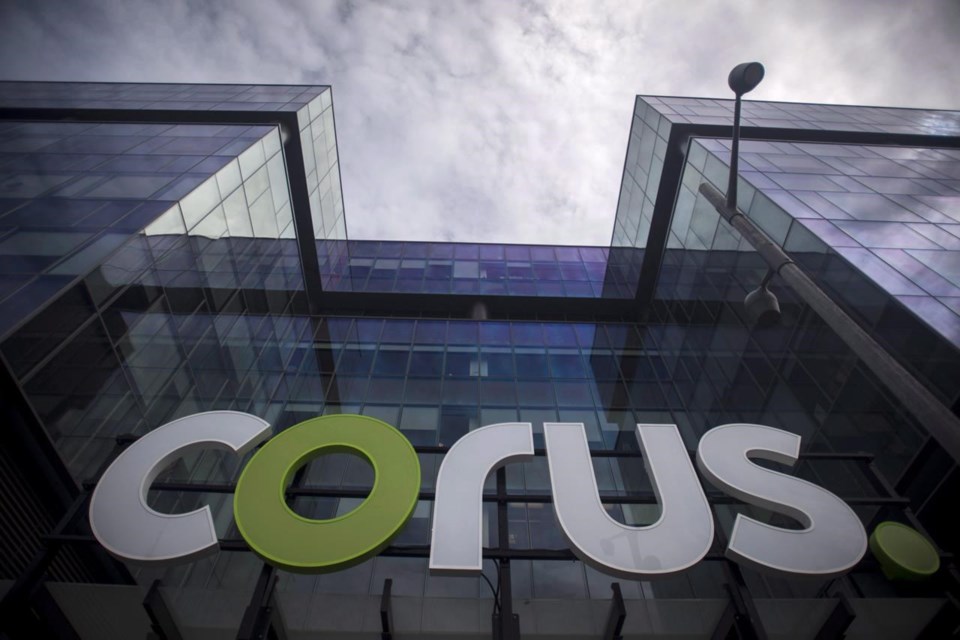TORONTO — Despite a drop in advertising revenue, the chief executive of Corus Entertainment Inc. says he is confident the television and radio broadcaster can draw advertisers back as it focuses more on growing digital and streaming audiences.
The company reported a loss attributable to shareholders of $9.8 million in its latest quarter compared with a loss of $15.5 million a year earlier as its revenue fell 13 per cent.
Revenue in what was the company's second quarter totalled $299.5 million, down from $343.9 million a year earlier. The drop came as television advertising revenue in the quarter fell 12 per cent from a year ago to around $149 million.
Those losses were despite promising audience levels seen across Corus' television networks and streaming platforms, said CEO Doug Murphy.
He said there could still be lingering effects from last year's Hollywood strikes that caused an advertising slump or "other ongoing distortions in the advertising market, whether it be from the economy or increased competition."
"What we do know is that the advertising market is just beginning to digest the impact of the return of audiences for popular scripted shows on linear television and across related platforms," said Murphy.
In its outlook, Corus said it expects a year-over-year decline in television advertising revenue in its third quarter in the 10 to 15 per cent range. It also said amortization of TV program rights is expected to decline in the quarter by a similar range on a year-over-year basis and that it will continue cutting costs.
Total television revenue in the second quarter fell to $278.1 million compared with $321.5 million last year, while radio revenue slipped to $21.5 million compared with $22.3 million a year earlier.
Murphy said industries such as telecommunications, alcoholic beverages, direct-to-consumer and retail have reined in their advertising budgets. Meanwhile, health and beauty companies have redirected their television advertisement spending to social media and online influencers, he said.
But he struck an optimistic tone, touting a "rising tide of audiences" that are still seeking the content Corus provides, including through traditional television networks and its three streaming platforms, StackTV, Global TV and Pluto TV.
He said those apps are the cornerstone of Corus' strategy, called Video First, that seeks to redefine the company as not just a broadcaster, but "an aggregator of premium video across all platforms."
"It's clear viewers will seek out great content on their preferred platform and we're seeing this play out across our Video First ecosystem," said Murphy.
"It is a 'Field of Dreams' moment, a critical mass of premium video ... Shows made by actors, writers and directors delivering tried and true and trusted content that advertisers ultimately will come to, given the growth the industry has built in impressions and audiences."
Corus said its loss amounted to five cents per diluted share for the quarter ended Feb. 29 compared with a loss of eight cents per diluted share in the same quarter last year. On an adjusted basis, Corus said it lost three cents per share in the quarter compared with an adjusted loss of seven cents per share a year earlier.
RBC analyst Drew McReynolds said the results were in line with expectations, noting the television advertising outlook for the third quarter is softer than previous forecasts.
"With still limited visibility on the recovery in television advertising, we view results as an incremental negative for the shares at current levels," he said in a note.
Murphy said Corus continues to reduce costs following job cuts and a programming reduction plan that began last year. He said the company lowered expenses by 13 per cent, or $38 million, in its last quarter and has slashed 15 per cent of costs, or $88 million, year to date.
"We are doing this while waiting for the CRTC to finally implement a new regulatory regime to replace the exasperatingly sclerotic processes of the past," he said.
Corus asked the regulator last fall to “urgently” change some conditions for its English-language television stations and discretionary services. That included a plea to lower the company’s obligation to spend 8.5 per cent of revenues on programs of national interest for its English-language stations to five per cent.
The commission had said it was in favour of granting the company’s request but wanted to first hold a consultation. Murphy said Friday that Corus hasn't received an update yet.
"Every passing year, quarter and even month brings new reminders that our framework is broken and unsustainable," he said.
"Federal broadcasting rules continue to wrongly assume that Canadian broadcasters are the only place that Canadians consume content and these assumptions now hold us back in an increasingly cross-platform environment."
This report by The Canadian Press was first published April 12, 2024.
Companies in this story: (TSX:CJR.B)
Sammy Hudes, The Canadian Press




